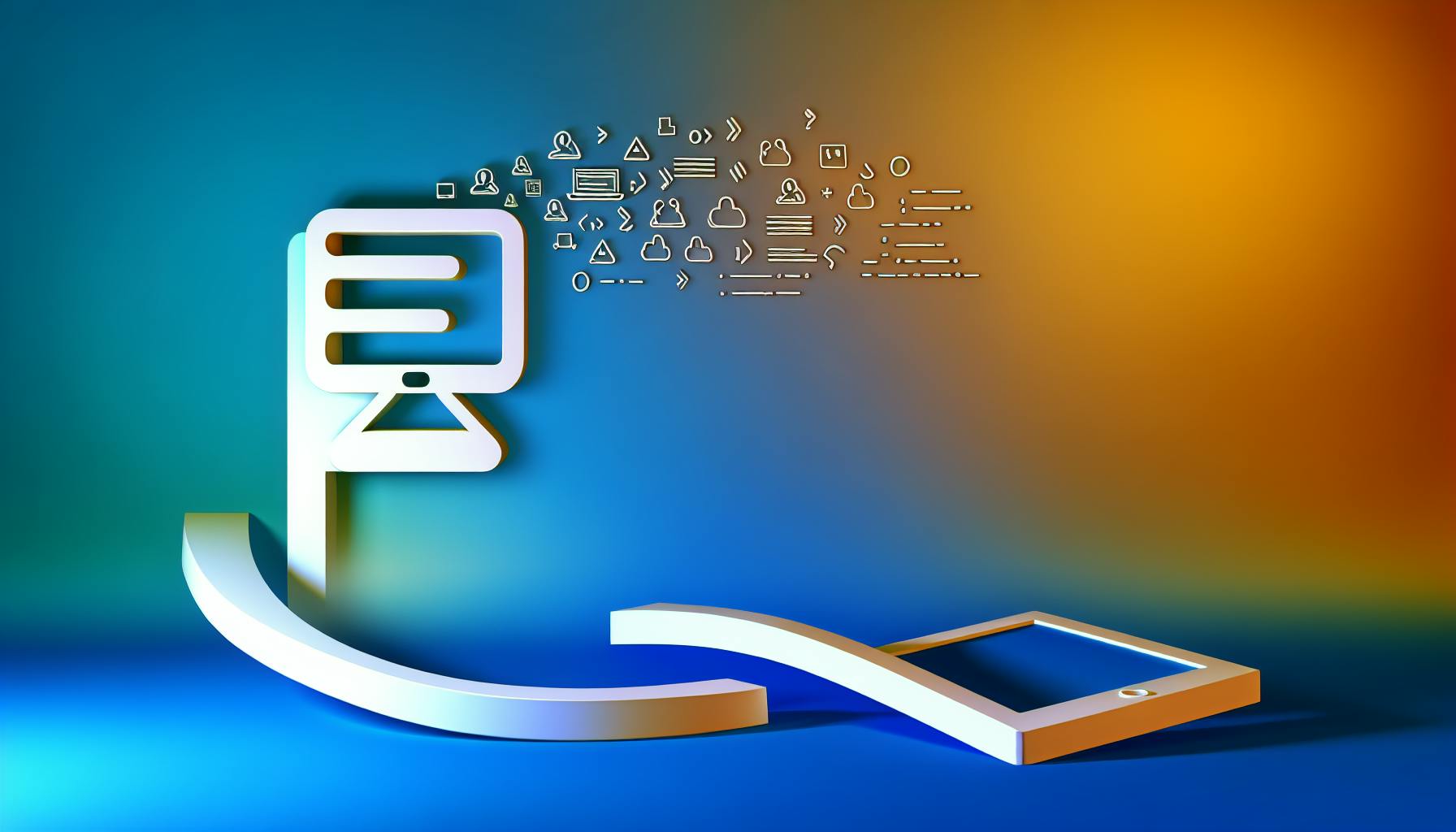Looking for the lowdown on low code platforms? The latest Forrester Wave report reveals which ones are leading the pack and why they're so crucial for today's fast-paced app development world. Here's what you need to know in a nutshell:
- Top Picks: OutSystems, Mendix, and Microsoft Power Platform are the frontrunners, offering powerful tools for both seasoned and novice developers.
- Why Low Code?: These platforms accelerate app development, help bridge the developer skills gap, and support the creation of apps across various devices.
- AI and Cloud Integration: Leading platforms are leveraging AI and cloud technologies to enhance ease of use, scalability, and integration capabilities.
- For Developers: While initially aimed at non-professional developers, these platforms now also cater to pros with more sophisticated needs.
Whether you're a tech leader looking to streamline your development process, a professional developer seeking efficient tools, or a business aiming for rapid digital transformation, understanding the strengths of these top low code platforms can guide your next move.
Evaluation Criteria
When Forrester checked out these low code platforms, they looked at lots of different things, split into three main groups:
- Current offering - What the platform can do right now. This part was really important and looked at stuff like:
- Low-code capabilities - How easy and quick it is to make apps without needing to write a lot of code.
- Developer experience - How nice the platform is to use for the people making the apps.
- Enterprise grade RMAD - If the platform is good enough for really important apps that need to be super reliable and easy to keep an eye on.
- Strategy - What the company behind the platform plans to do in the future. This included things like:
- Vision and roadmap - How clear and realistic their plans are.
- Performance and scalability - If the platform can handle more complex and bigger apps as time goes on.
- Ecosystem - How well it works with other tools and if there's a place to get pre-made parts for your apps.
- Market presence - How well-known and used the platform is. This looked at:
- Revenue and customer count - How many people are using it and if it's growing.
- Geographic reach and vertical industry coverage - If it's available in lots of places and suitable for different types of businesses.
Forrester scored each platform from 1 (not so good) to 5 (really good) on these criteria. Then they added up these scores to see who came out on top.
Overview of the Forrester Wave Findings
The latest report from Forrester Wave gives us a good look at the best low code platforms out there. Here's what they found:
OutSystems and Mendix lead the pack
OutSystems and Mendix are at the top. They did really well in three big areas:
- Current offering - OutSystems is great at letting people make apps easily, feels good to use, and is ready for big, important projects. Mendix is also really good here.
- Strategy - Mendix and OutSystems have solid plans for the future. They're working on making their platforms even better and growing their networks.
- Market presence - Both OutSystems and Mendix are big names with lots of users all over the world, and they're growing fast.
Low code adoption is accelerating
More and more people are using low code platforms. OutSystems and Mendix help make creating big, important apps faster and easier. Here's why more folks are jumping on the low code train:
- Companies need to move fast and change things up digitally.
- There aren't enough skilled coders out there.
- People want to make apps that work on phones, computers, and even wearables.
- Low code is now being used for really critical stuff.
Vendors optimizing for professional developers
At first, low code was all about helping non-coders make apps. But now, Forrester says these platforms are getting better for pro coders too.
What they're doing for pros:
- Making it easier to customize things.
- Improving the tools and experience for coders.
- Making sure everything is secure and up to standard.
- Ensuring the platform can handle big, complex apps.
The top picks for pros are OutSystems, Mendix, and Microsoft Power Platform.
AI and cloud capabilities expanding
Forrester points out that AI help and cloud tech are becoming big deals. Leaders like OutSystems, Mendix, and Appian are using:
- AI to make low code even easier.
- Cloud tech to make apps run smoother and be more flexible.
- Better integration with big cloud services like Azure, AWS, and Google Cloud.
These are the exciting new developments to keep an eye on.
Analysis of Leading Low Code Platforms
The Forrester Wave report shows us that the world of low code platforms is growing fast. Let's take a closer look at the top players to see what makes them stand out.
| Platform | Score | Market Presence |
|---|---|---|
| OutSystems | 4.64 | Leader |
| Mendix | 4.61 | Leader |
| Microsoft Power Platform | 4.47 | Leader |
| Appian | 4.05 | Strong |
| Quickbase | 3.66 | Contender |
OutSystems and Mendix Lead the Pack
OutSystems and Mendix are the top dogs according to Forrester. They both scored really high for what they offer now and their future plans, showing they're not just good; they're planning to get even better.
OutSystems shines because it lets people build apps by just dragging and dropping parts, no need for lots of coding. Mendix is also up there, especially with its teamwork features and help from AI to make app building easier.
Both OutSystems and Mendix are big names worldwide. They're growing quickly, adding more customers, and covering lots of different businesses.
Microsoft Enters as a Top Contender
Microsoft has made a splash with its Power Platform, scoring high across the board. It uses its cloud service, Azure, to help people build apps for businesses easily.
Forrester likes how well Power Platform works with other Microsoft tools. If you're already using Microsoft stuff, Power Platform fits right in, making it a strong choice.
Vendors Optimizing for Professional Developers
Low code platforms started out for people who don't usually code. Now, they're getting better for professional developers too. The big names like OutSystems and Appian are doing things like:
- Making it possible to tweak and change apps more.
- Adding features for more complex coding.
- Making sure apps are secure and can be managed well.
- Helping developers keep an eye on how well apps are doing.
This means low code is not just for simple apps anymore. It's getting ready for bigger, more important projects.
Expanding AI and Cloud Capabilities
The newest thing in low code is using AI and the cloud to make building apps even better.
Companies like OutSystems and Quickbase are making AI helpers that make app building a breeze. Others, like Microsoft Power Platform and Appian, are making sure their platforms work great with cloud services, so apps can handle more users without a hitch.
Forrester says OutSystems is really pushing forward with AI and cloud, planning to add lots of new features in the next few years.
As low code gets ready for bigger tasks, having AI and cloud tech will become a must-have.
Key Trends and Insights
The Forrester Wave report points out a few big trends in how people are making apps with less code that tech folks should know about.
Accelerating Adoption of Low Code Platforms
More and more people are using low code platforms, and it's expected to keep growing fast. Here's why:
- Companies want to make new digital stuff quicker.
- There aren't enough people who know how to code well.
- Everyone wants apps that work on all kinds of devices.
- Low code is now being used for really important projects.
This means more businesses are putting money and effort into low code.
Optimization for Professional Developers
Low code used to be for people who don't code much, but now it's also for the pros. New features for them include:
- Better ways to make changes and add custom stuff.
- Better tools and environments for coding.
- Strong security and ways to manage the app's life cycle.
- The ability to make complex apps for big businesses.
OutSystems, Mendix, and Microsoft Power Platform are doing a great job for these pro developers.
Expanding AI and Cloud Capabilities
AI and the cloud are becoming more important for low code platforms. The leaders are adding AI to make app making easier and using the cloud to handle more users and make apps work better together.
Some cool new things include:
- AI that helps with app development.
- Working well with big cloud services like AWS, Azure, and GCP.
- Options for running apps fully on the cloud.
- More services offered right from the platform.
OutSystems, Appian, and Quickbase are spending a lot on these areas.
Takeaways for Tech Professionals
As low code gets more popular, tech leaders should:
- Look at the top low code platforms to make things faster.
- Consider options that are good for pro developers for big projects.
- Pick modern platforms with cloud and AI to make sure they're ready for the future.
With more people using low code, now's a good time to start seeing it as a key tool.
sbb-itb-3a330bb
Forrester's Predictions
Forrester, a big name in tech research, has some guesses about what's next for low code platforms. These are tools that let you make apps without needing to be a coding expert. Let's dive into what they think is coming up.
Continued Strong Growth in Low Code Adoption
Forrester thinks more and more people will start using low code platforms. They say this market could grow by 23% each year until 2024, reaching almost $30 billion. Here's why:
- Businesses want to make apps faster to keep up with changes.
- There aren't enough trained developers around.
- People want apps that work everywhere, like on phones and computers.
- These tools are getting better, even for really important apps.
This means companies will keep investing in low code because it helps them do more, quicker.
Advancing Platform Capabilities
Forrester also sees these platforms getting a lot better:
Smarter AI Assistance
Expect AI to make building apps even easier. This means the platforms will guess what you need and help you do it faster.
Expanded Cloud & Mobile Features
They'll work better with the cloud, which means apps can handle more people using them without problems. They'll also make it easier to create apps that work well on phones.
Tighter Ecosystem Integration
These platforms will play nicer with other tools you might use for designing apps or managing data. There will be more add-ons and extras to choose from, too.
Improved Developer Experience
They're going to be more friendly for professional developers, with better security and the ability to make complex apps. Things like keeping track of changes and testing apps will get easier.
What It Means for Tech Professionals
Forrester's ideas suggest that low code is becoming a big deal for making apps. Tech leaders should:
- Check out the best low code platforms to speed up app making.
- Look for platforms that can handle big projects.
- Go for the latest tools that are keeping up with new tech like AI and the cloud.
With more people using low code, it's a good time to think about how it can help you or your business.
Impact of AI on Low Code
AI is becoming super important in making low code platforms even better. Here's a quick look at how AI is shaking things up:
Intelligent Assistance in App Building
AI is getting mixed into low code platforms to help out more when you're building apps. This includes cool stuff like:
-
Intuitive visual interfaces - These are like the easy drag-and-drop tools that now suggest what to use next or finish tasks for you, thanks to AI.
-
Code suggestions and automation - AI looks at what your app is trying to do and offers hints on what code to use next, making the building process faster by cutting down on the need to write everything from scratch.
-
Testing optimization - AI can keep testing your app and getting better at finding issues, making sure your app works well without needing extra rounds of checking.
AI helps developers skip the boring parts and spend time on bigger ideas.
Enhanced Analysis of App Performance
AI tools inside low code platforms can track how people use your app and figure out ways to make it better by:
- Spotting parts of your app that could work better.
- Finding ways to make the app's processes smoother.
- Seeing new chances for making things work automatically or together.
This loop of checking and improving based on real use makes your app and business more flexible.
Expanded Platform Scalability
AI is also helping low code platforms grow with your business. This includes:
Auto-scaling cloud infrastructure - AI can adjust how many online resources your app uses, so you're not paying for more than you need or running out when more people visit your app.
Demand forecasting - AI predicts when your app will get busy so you can be ready and keep everything running smoothly.
AI makes sure low code platforms can handle more work without breaking the bank.
The Future with AI
Forrester thinks AI in low code platforms is just getting started and will bring in new features like:
- Talking and seeing abilities for apps to understand natural human actions.
- Automatic design tools that make how your app looks without needing a designer.
- Easy ways to get to all your business data from one place.
- Better ways for teams to work together, even when they're not in the same place.
AI is key to making low code platforms do more for businesses in the future.
Case Studies
Forrester's research shows how different companies use low code platforms to solve big problems and get things done faster and cheaper:
Manufacturing Company Automates Processes
A big manufacturing company in China started using the OutSystems low code platform to make web apps that help manage how they make and track products.
Here's what they got out of it:
- They spent 60% less money making these apps.
- They cut down the time to plan production from 5 days to just 4 hours.
- They managed to make 30% more products thanks to better efficiency.
Now, they're looking at using it for apps that handle shipping and tracking stuff.
European Bank Builds Customer-Facing Apps
A big bank in Switzerland used the Mendix low code platform to quickly make apps for their customers to use on their phones.
Here's the difference it made:
- They cut the time to make these apps in half.
- They got a new banking app out in less than 6 months.
- They could make changes faster based on what customers said.
- They made all their mobile apps look and work the same way.
They're still using low code to bring out new features for digital banking faster.
Healthcare Provider Automates Back-Office
A group of hospitals in Australia chose the Quickbase low code platform to make their office work like scheduling and managing supplies smoother.
What they achieved:
- They cut down on office work by over 30%.
- They made billing super fast, going from 10 days to just one day.
- Staff could find information 75% quicker.
- They made their booking and pharmacy stock more accurate.
Next up, they want to make patient check-in and records digital.
Conclusion
The Forrester Wave report sheds light on low code platforms, making it easier to understand what's happening in this space. Here's what you need to know:
More people are using low code platforms. With the need for apps going up and not enough developers to build them, low code platforms help make apps faster. Big names like OutSystems and Mendix are helping a lot of people do this.
These platforms are also great for expert developers now. At first, they were made for folks who don't code much. But now, they have features that professional developers will find useful, like:
- More ways to make the app your own
- Better tools for finding and fixing problems
- Strong protection for your app
- Keeping an eye on how well the app performs
AI and the cloud are playing a bigger role. The top platforms are using AI to make building apps easier and the cloud to make apps work better and handle more users.
Pay attention to the leading platforms. OutSystems, Mendix, and Microsoft Power Platform are ahead because they offer a lot, have good plans for the future, and many people use them.
Look for platforms that work well for developers. When picking a low code platform, choose one that offers the right tools for building complex apps.
Go for platforms that are up-to-date. Choose platforms that are investing in AI, the cloud, and new tech to make sure they can handle your needs as they grow.
Forrester thinks low code will become even more important for making apps. By choosing the right platform, tech leaders can use these tools to quickly improve their digital services.


